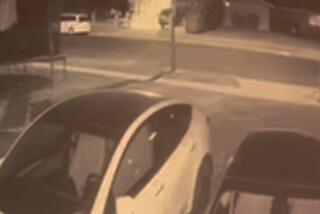Black church fires raise fears; crime data suggest blazes are not unusual
Thousands of social media users are tweeting the same question: Who is burning black churches?
Fires at six black churches in the South over the last 10 days have stirred fears that racial violence on houses of worship is making a comeback — perhaps as a backlash to criticism of the Confederate flag since nine black worshipers were slain, allegedly by a white supremacist, at a church in Charleston, S.C.
The flames evoke a haunting reminder of white supremacist terrorism from decades ago.
The fires also ignited an online army of activists who coalesced during the street protests in Ferguson, Mo., and who have become a kind of rapid-deployment force for black America. Their passion for justice and skepticism of investigators’ accounts have been a regular presence after police shootings.
This week, their focus has been on church fires. But investigators say only two of the six blazes have been confirmed as arsons, not one has been declared a hate crime and they are not connected.
“We are in the early stages of these investigations, but at this time we have no reason to believe these fires are racially motivated or related,” the Bureau of Alcohol, Tobacco, Firearms and Explosives said in a statement.
Some data suggest the number of church fires may not be that unusual. But as with police shootings after Michael Brown was killed in Ferguson, each church incident is getting extra scrutiny.
“Stop the passive language. Fires aren’t ‘breaking out’ at black churches. Black churches are being set on fire,” one person tweeted.
“At what point are we allowed to say black America is under attack?” tweeted another.
“If the government watched the KKK as hard as they do #BlackLivesMatter, maybe we would know #WhoIsBurningBlackChurches,” tweeted a third.
Each remark earned hundreds of retweets.
Their concerns were backed by the NAACP’s president, Cornell William Brooks.
“The spike in church burnings in Southern states over the past few days requires our collective attention,” especially after the June 17 slayings in Charleston, he said in a statement Wednesday.
“When nine students of Scripture lose their lives in a house of worship, we cannot turn a blind eye to any incident,” Brooks said.
“As we wait for authorities to conduct their investigations, the NAACP and our state conferences across the country will remain vigilant and work with local churches and local law enforcement to ensure that all are taking the necessary precautions to ensure the safety of every parishioner,” Brooks said, adding, “We will use every tool in our advocacy arsenal to preserve these beloved institutions.”
The alarm echoes concerns raised in the 1990s when a surge of church arsons — especially against black churches in the South — led to tougher arson laws and creation of a church arson task force made up of federal and local officials.
Of 827 arsons, bombings or attempted bombings at religious buildings that the National Church Arson Task Force investigated between 1995 and 1999, at least 269 involved black churches, 185 of them in the South.
That ugly time remained fresh in the mind of Greeleyville, S.C., Mayor Jessie Parker, who visited the smoldering remains of the city’s Mt. Zion African Methodist Episcopal Church on Wednesday after a fire destroyed the sanctuary the night before.
Twenty years ago, Ku Klux Klan members burned Mt. Zion AME. Then-President Clinton toured the church after it was rebuilt and said, “We cannot let someone come into our democratic home, the home of our faith, and start torching our houses of worship.”
On Wednesday, Parker urged patience as investigators worked to determine the cause of the latest fire. “It gives you an ill feeling,” he told reporters. “It brought back all those old memories.”
Whether the recent fires are part of a backlash to the national mood since Charleston is unclear.
Church fires happen all the time, according to fire response data gathered by the National Fire Protection Assn. Adding funeral home blazes — which the association does in its data — there were as many as five such fires a day across the U.S. in 2011. Although that sounds like a lot, it’s about half as many as in 1980.
Sometimes, the stricken churches are old and maintained by volunteers instead of professionals. Steeples present a high-profile target for lightning. And cooking implements may have been left on after parishioners and clergy left the building.
In 2011, the U.S. saw an average of about five arsons a week, according to the fire association’s data — a rather large number of church and funeral home attacks that have received little national media attention.
The culprits often are teenagers and the fires are small, said Marty Ahrens, senior manager of fire analysis services for the association.
“For some people, places of worship, maybe they’re like schools: a place of authority for kids” to target, Ahrens said. “Some of the arsons are just plain vandalism.”
So are the recent black church fires a trend? Or are the media just paying more attention?
“It’s hard to know,” Ahrens said, adding that the media could contribute to the problem.
“Right now, I am afraid that there is the potential for copycats,” he said. “I understand that you need to tell stories and publicize news, but there is a type of individual that can be motivated by doing something that gets wide coverage.”
More to Read
Start your day right
Sign up for Essential California for news, features and recommendations from the L.A. Times and beyond in your inbox six days a week.
You may occasionally receive promotional content from the Los Angeles Times.







